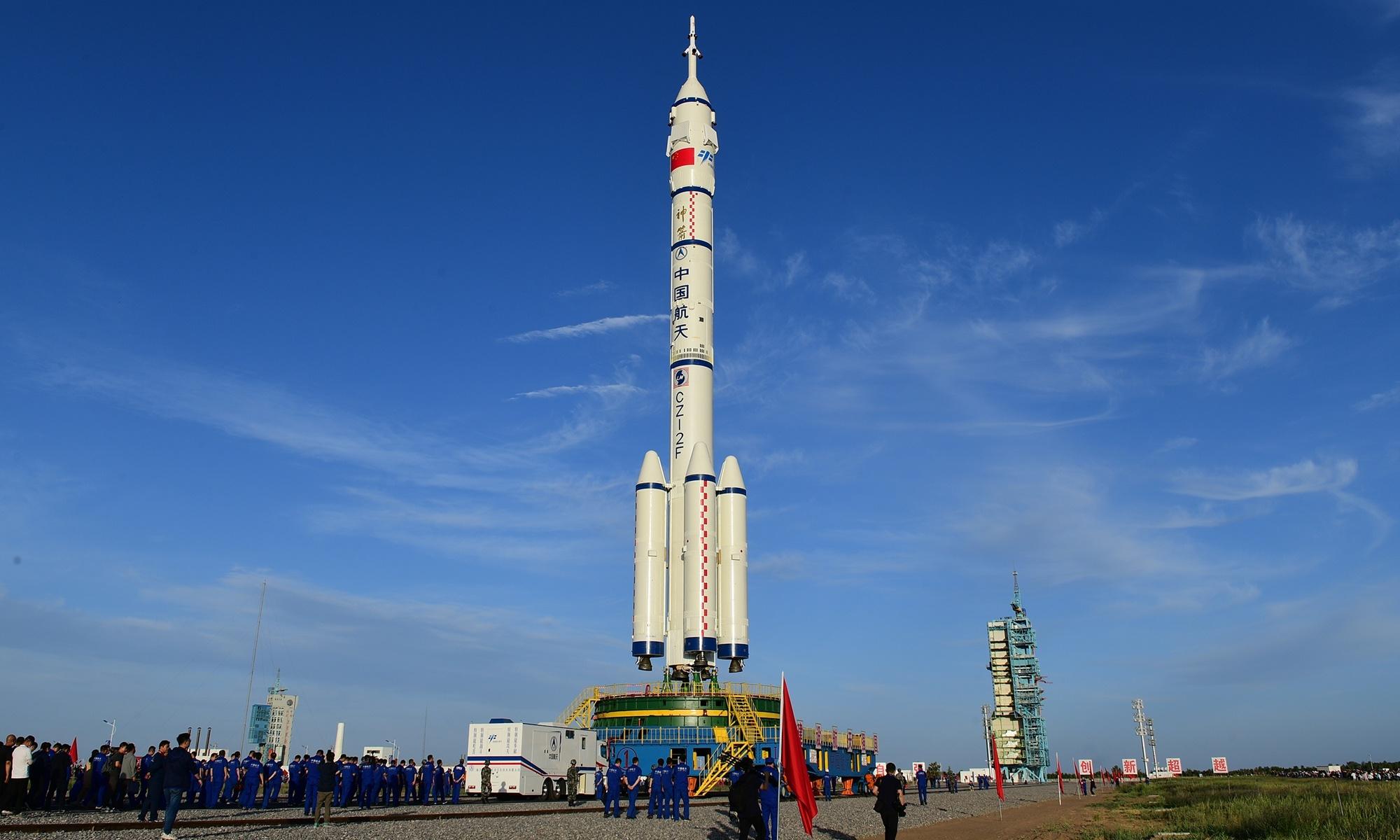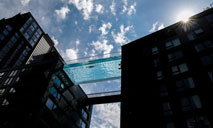China's first crewed space station mission draws closer

China's Long March-2F Y12 carrier rocket and the Shenzhou-12 spacecraft are moved to the launch pad at the Jiuquan Satellite Launch Center in Northwest China's Gansu Province on Wednesday. Shenzhou-12 will send three Chinese astronauts to China's Tianhe space station core cabin. Photo: Wang Jiangbo
China's space station Tianhe core cabin is expecting its first visitors as the combination of the Long March-2F Y12 carrier rocket and Shenzhou-12 manned spacecraft tasked to ferry three astronauts to the space station was vertically transferred to the launch pad on Wednesday.
Chinese space observers reached by the Global Times on Thursday expressed confidence in the upcoming crewed mission, saying that a successful launch and docking of Shenzhou-12 would mean China's Earth-space shuttling technology has further matured and become routine to support succeeding missions to and from the space station, a feat rarely achieved in the world.
The combination of the Shenzhou-12 manned spaceship and the Long March-2F Y12 carrier rocket was transferred to the launching area, according to the China Manned Space Agency (CMSA) on Wednesday.
The facilities and equipment at the launch site are in good condition, and various pre-launch function checks and joint tests will be carried out, said the agency.
Dubbed the "gold medal player" of China's manned space missions in the rocket family, the 58.34 meter-long, 3.35 meter in diameter Long March-2F carrier rocket is capable of sending a payload of 8.6 tons to low Earth orbit. The rocket has four 2.25-meter-in-diameter boosters and a weight at launch of 479.8 tons, according to rocket developers.

Shenzhou-12, China's first crewed space station mission, explained Graphic: Jin Jianyu, Xu Zihe/GT
The rocket is the only type of carrier rocket that supports manned spaceflights, and has sent 11 astronauts to space since its first flight in 1999, according to rocket developer China Academy of Launch Vehicle Technology.
Chinese space authorities have yet to announce the line-up of the first three-strong flight crews, but Yang Liwei, director of the China Manned Space Engineering Office and the country's first astronaut, revealed that they were chosen from China's first and second batch of astronauts, and are now under Level-2 quarantine, with all related work having entered a final stage.
The astronauts will stay in orbit for three months, during which they will conduct multiple tasks in and out of the cabin, including repair and maintenance, appliance switch and scientific operation of payloads, Yang introduced.
Some foreign space industry media such as the US-based spaceflightnow.com speculated that the launch of the Shenzhou-12 spacecraft could take place around June 16 or 17. "China's last three crewed spaceflights rolled to the pad about a week before liftoff," the website said.
Chinese space authorities have yet to announce the launch date of the mission.
Song Zhongping, a space analyst and TV commentator, told the Global Times on Thursday that China has accumulated rich experience in such practices, and with the "golden partnerships" of Long March-2F and Shenzhou-12, which made a series of improvements on the reliability and safety of the craft, the mission will be carried out smoothly.
With the successful launch of Shenzhou-12, China will achieve a three-peat in the initial phase of the country's first space station construction in less than two months. "It verifies China's Earth-space shuttling capability, enables frequent missions to and from the space station, and lays a solid foundation for succeeding missions during the two-year schedule as well as future deep-space explorations," Song noted.
It makes China a major power in the aerospace field, he added.
"The task plan for Shenzhou-12 was initially made in 1992 at the very beginning of China's manned space project. Step by step and steadily, we have managed to stay true to our original aspirations," Shao Limin, deputy manager in charge of Shenzhou-12 spacecraft, said at an interview in the China Aerospace Science and Technology Corporation (CASC.)
According to Shao, another major progress is the emergency rescue ability and spacecrafts' quick roll-outs from the launch pad, in case astronauts at the space station encounter situations in need of immediate pick-ups from space.
China launched its Tianzhou-2 cargo spacecraft for a supply missionto the Tianhe space station core cabin on May 29, which performed an ultra-fast automatic docking with the Tianhe module - within eight hours after launch. Two space suits for astronauts' outside-cabin activities, which weigh more than 100 kilograms each, as well as daily supplies were delivered.
China is also developing its next-generation two-module manned spaceship, which carried out a successful un-crewed test flight via a Long March 5B carrier rocket last month. Its return capsule returned to Earth three days after the launch.
Pang Zhihao, a Beijing-based senior space expert, told the Global Times that the 9 meter-long, 4.5 meter in diameter spacecraft can ferry up to seven people to space, and is capable of flying both in low Earth orbit and to the moon and other deep-space explorations.
The next-generation spacecraft is cozier, smarter and more cost-effective than the Shenzhou series, adopting a cabin return plan consisting of two decelerating parachutes and three main parachutes, as well as six air bags that will be opened before the craft's touchdown, ensuring a safer and steadier soft landing, Pang noted.
A new type of heavy-lift carrier rocket that supports lunar manned explorations is also being developed, Mou Yu, an official at China's Academy of Launch Vehicle Technology's general designing department, told the Global Times in April.
Such a rocket would be capable of launching a payload of no less than 50 tons to the lunar orbit, which will strongly support moon base building, as well as bigger lunar exploration activities, Mou said.
Photos
Related Stories
- Effective power supply energizes China's space station project
- SpaceX launches tiny critters, solar panels to space station
- China launches cargo craft for space station supply, refueling mission
- New advances inspire China's deep space exploration
- China's space station designers extend its in-orbit life
Copyright © 2021 People's Daily Online. All Rights Reserved.










